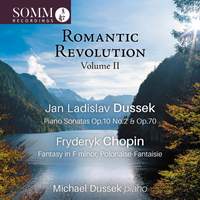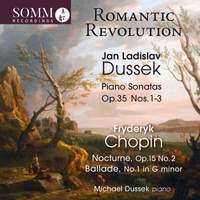Interview,
Dussek on Dussek
 Among the "forerunners" of piano Romanticism to whom increasing attention is being paid - John Field, Hélène de Montgeroult and others - stands Jan Ladislav Dussek, a Bohemian composer who particularly influenced Chopin both technically and harmonically, as well as driving forward the development of the piano itself and exploring what the instrument could do.
Among the "forerunners" of piano Romanticism to whom increasing attention is being paid - John Field, Hélène de Montgeroult and others - stands Jan Ladislav Dussek, a Bohemian composer who particularly influenced Chopin both technically and harmonically, as well as driving forward the development of the piano itself and exploring what the instrument could do.
His distant descendant, pianist Michael Dussek, is perfectly placed to explore this link, which he continues to do in the second volume of his "Romantic Revolution" series on Somm, released late last year.
I spoke to Michael about the impact of Dussek's music on his successors, and about the family connection.
It may not be strictly relevant to the music, but the story about Napoleon is too good to pass up – how much truth is there in the rumours that Napoleon played the violin with Dussek?
I read this on Wikipedia where it says simply that “During his time in Paris he (Dussek) may have met and played with a violinist by the name of Napoleon Bonaparte.” This is why I describe it in the sleeve notes as “delightful speculation”. But what is beyond dispute is that Dussek was employed from 1787-1789 by Marie-Antoinette who, according to Scholes Oxford Companion to Music, “tried in vain to retain his services”. Wisely, as it turned out, Dussek moved to London, where he spent the 1790s. He returned to Paris in 1807 in the employment of Talleyrand where he performed the A flat major Sonata, Le Retour à Paris, which features on the second volume of Romantic Revolution. Very shortly before Dussek’s death in 1812 he played for Napoleon before the latter’s departure on his Russian campaign. According to the piano tuner who was present and related this story more than three decades later, Napoleon complimented Dussek on his singing style of playing, saying “The instrument under your fingers produces an entirely different tone”.
Dussek is apparently credited with being the first pianist to perform a recital side-on to the audience, as is now the norm. Is this true, and if so why did he make this break with tradition?
This certainly appears to be true, apparently on account of his striking profile, causing him to be named “le beau visage”. Presumably the use of the piano lid to direct the instrument’s sound towards the audience must have coincided with this new development. Only in exceptional circumstances, such as directing a concerto from the keyboard, or performing music for two pianos, does anyone now depart from this tradition.
In another musical first, Dussek is also thought to have been one of the first to introduce the use of the sustain pedal in his performance. There’s a sense of chicken and egg here – when did sustain pedals first appear in piano design and how did they influence composition for the instrument?
This is a fascinating subject about which entire books could be written. One needs to remember how very new the pianoforte was and how much it was extended and developed in the century c.1770-1870. Beethoven apparently described Mozart as playing the piano “like a harpsichordist” and it seems that during the 1790s Dussek, collaborating with the piano manufacturers Broadwood, extended the instrument’s design and the expressive demands placed on it in a number of ways. Freidrich Kalkbrenner observed that “Dussek above all…used the pedal almost constantly when he played in public.” This transformed pedal usage from a special effect, as used occasionally in his late sonatas by Haydn, for instance, to an almost constant enhancement of the instrument’s expression. By sustaining the bass note with the pedal, the left hand becomes free to play more elaborate figurations while sustaining the harmony. Dussek is thought to be the first composer to have marked specific pedal instructions in his scores and I am not aware of any composer until Chopin whose music is so dependant on long, pedal-sustained harmonies. As Charles Rosen observes, pedal markings are rhythmical as well as harmonic, and it is surprising how many pianists feel at liberty to ignore or adapt them. It is true, though, that pianists need greater control of texture, voicing, articulation and, above all, accuracy if use of the sustaining pedal is not to become, in Hummel’s words “a cloak to an impure and indistinct method of playing”.
You’ve paired Dussek with Chopin on this album – how much influence did Dussek’s music have on Chopin’s development as both a pianist and a composer?
It has always been recognised that Dussek was ahead of his time both as a pianist and composer. Grove writes, “As has been frequently observed, much of Dussek’s music resembles that of other composers. Most often, however, these composers are later than Dussek, and such resemblances show him to be very much ahead of his time in the development of a Romantic piano style.” Several listeners to these recordings have noted resemblance to Schubert, which I can detect in the music’s lyricism and also the scales in the last movement of the A flat major sonata, which certainly seem to anticipate Schubert’s E flat major Impromptu. But no-one ever suggested that Schubert was a virtuosic pianist and the pedal plays a much less crucial role in his music than in Chopin’s.
Others liken Dussek to Liszt based, perhaps, on their shared careers as performing virtuoso pianists and, possibly linked to that, a certain frivolity at times in their approach to composition. But Liszt’s piano style is very different from Chopin’s, descended via Czerny from Beethoven; far more weighty and thickly voiced. But as soon as I started playing Dussek’s music during the first lockdown in March 2020 I was struck by how much it felt like playing Chopin. As I write in the sleeve notes for the first volume, “There is something in the pianistic ease and naturalness of both composers which is similar. Both write the most virtuosic music of their eras, but without ever placing undue strain on the hand, even on modern pianos, which are so much heavier than those for which the music was written.”
Then there is the whole approach to cantabile and legato. To quote from Harold Schonberg’s definitive book, The Great Pianists, which, perhaps more than any other, encapsulates Dussek’s massive influence on pianistic development, “Dussek’s fingerings, too, were far in advance of his day, and he anticipated Chopin in his ideas about shifting fingers on the same key without actually striking it, so as to get a pure legato – or, as Dussek explained it, “to hold the vibration and to tie or bind one passage to another”. Johann Tomaschek wrote that Dussek “extracted from the instrument delicious and at the same time emphatic tones. His fingers were like a company of ten singers endowed with equal executive powers and able to produce with the utmost perfection whatever their director would require”. Schonberg observes that “Nobody ever referred to Beethoven’s singing style”. I continue to believe that there might be some common root of Bohemian polyphonic choral music which influenced both Dussek and Chopin’s teacher Wojciech Żywny (the final entry in every music dictionary) who was born in Bohemia in 1756, four years before Dussek.
Grove comments in its entry on Dussek’s pupil John Field (whose influence on Chopin is undisputed) that any trace of the sentiment of his later Nocturnes was to be found at the turn of the 19th century, not in Field’s early works, but rather in Dussek’s C minor Sonata, Op. 35/3, which I include in Volume 1 of Romantic Revolution. I think it is entirely possible that the short B major section in the second half of this sonata’s 2nd movement, with cantabile right hand melody, broken chord accompaniment and florid, free right hand ornamentation, might actually be the first example of what was to become Romantic piano style. And this style is far more developed and Chopinesque in the 2nd movement of the A flat major Sonata included in Volume 2, written three years before Chopin was born. I try also to demonstrate here that the first movement of this sonata is harmonically similar, and every bit as complex, as Chopin’s late Polonaise-Fantaisie, including the frequent A flat-G sharp pivot which takes the music from A flat major to E major.
As one reviewer of Romantic Revolution, Volume 2, has written, “The Piano Sonata in A flat, Op. 70 “Le retour à Paris” is by any standards a masterpiece. And there is no denying that this highly inventive music provides as convincing as any bridge between the elegance of Viennese Classicism and the exploratory yearnings of the Early Romantics.” Its ending is so similar to the ending of Chopin’s F minor Fantasie (also included in Volume 2) that I believe there must be some conscious or subconscious connection. Ludwig Rellstab, music critic and poet of the first seven of Schubert’s Schwanengesang cycle wrote in 1850 (the year after Chopin’s death, and nearly 40 years after Dussek’s) that Dussek “having accomplished a vast deal more for the elevation of the piano than most of his contemporaries, occupied a place in the musical life of Berlin which is felt even now.” If this was the case in Berlin, where Dussek never lived, how much more so in Paris, where both he and Chopin spent significant amounts of their lives. In short, Chopin is known to have played and taught Dussek’s works and I believe the influence to have been massive, quite independently of Dussek’s influence on Field as teacher and fellow member of the London Piano School in the 1790s.
How much do you know about the subsequent generations of Dusseks between Jan Ladislav and yourself? Were there other musicians and composers?
Dussek fled London in 1799, having become bankrupt due to the failure of his music publishing business with his father-in-law Domenico Corri and leaving, bizarrely, Mozart’s librettist Lorenzo da Ponte to settle his debts. All the music dictionaries say that there is no evidence that Jan Ladislav ever saw his wife Sophia or daughter Olivia again. This has obvious implications for our claim to be descended from him. However Howard Craw’s thoroughly researched 1964 doctoral thesis, which remains the definitive biographical source for Dussek, includes a letter dated April 22, 1806 written in the fondest terms from Jan Ladislav to Sophia in which he writes “In such a case as you and your father mention I cannot help returning to London”; and later “Adieu, my dear you cannot conceive how happy I am at the idea of seeing you so soon, though it deranges me in my projects”.
And in 1807 John Louis Dussek is born to Sophia, the initials and indeed the names indicating clearly the paternity (a nod, surely, to Jan Ladislav’s former employer, Louis XV1). John Louis’ first son, John Lewis Dussek, died young, but his second son, Alexander (1837-1892) was the grandfather of my grandfather, Ronald Dussek (1891-1962). Ronald and my father John Lawrence Dussek (JLD: 1922-1983) were both fine musicians in the great British public school Director of Music tradition - Radley College and Oakham School respectively: organists, choir trainers, orchestral conductors, piano accompanists, academic teachers and, as required, occasional composers. I probably peaked as a composer aged 9 with a published setting of the Christmas carol “Sweet was the Song” and stopped composing aged 17. As far as I know there were no musicians in the family between Jan Ladislav Dussek and Ronald Dussek.
Michael Dussek (piano)
Available Formats: CD, MP3, FLAC, Hi-Res FLAC
Michael Dussek (piano)
Available Formats: CD, MP3, FLAC, Hi-Res FLAC




